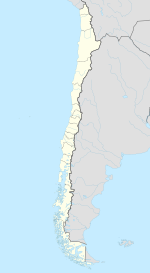Arauco, Chile
| Arauco | ||||||
|---|---|---|---|---|---|---|
| City and Commune | ||||||
|
||||||
| Coordinates (city): 37°15′S 73°19′W / 37.250°S 73.317°WCoordinates: 37°15′S 73°19′W / 37.250°S 73.317°W | ||||||
| Country | Chile | |||||
| Region | Bío Bío | |||||
| Province | Arauco | |||||
| Founded | 1552 | |||||
| Government | ||||||
| • Type | Municipality | |||||
| • Alcalde | Juan Mauricio Alarcón Guzmán | |||||
| Area | ||||||
| • Total | 956.1 km2 (369.2 sq mi) | |||||
| Elevation | 12 m (39 ft) | |||||
| Population (2012 Census) | ||||||
| • Total | 34,902 | |||||
| • Density | 37/km2 (95/sq mi) | |||||
| • Urban | 24,269 | |||||
| • Rural | 10,604 | |||||
| Demonym(s) | Araucano | |||||
| Sex | ||||||
| • Men | 17,603 | |||||
| • Women | 17,270 | |||||
| Time zone | CLT (UTC−4) | |||||
| • Summer (DST) | CLST (UTC−3) | |||||
| Area code(s) | 56 + 41 | |||||
| Website | Official website (Spanish) | |||||
Arauco is a city and commune (Spanish: comuna) in Chile, located in Arauco Province in the Biobio Region. The meaning of Arauco means Chalky Water in Mapudungun. The region was a Moluche aillarehue. The Spanish settlements founded here during the Conquest of Chile were destroyed on numerous occasions by the Mapuche during the Arauco War.
In 1552 Pedro de Valdivia the first governor of Chile, founded a fort, named San Felipe de Rauco or de Araucan. It was 12 km (7 mi) east of the location of the modern city of Arauco in the part of the valley immediately on the South or left bank of the Carampangue River at the point where on the opposite bank it receives the of Conumo. Valdivia planned it to be the base for a city he planned to found. The Mapuche destroyed the fort in 1554, after killing Valdivia's insane mother-in-law. It was raised again after the battle of Quiapo, by García Hurtado de Mendoza in 1559. Destroyed again in 1563 it was rebuilt again in 1566 by Rodrigo de Quiroga and became a small town, that remained so without growing until being transferred to the current site of the city of Arauco.
The population of old Araucan was moved in 1590 by Governor Don Alonso de Sotomayor to the seacoast, four kilometers to southwest of the mouth of the Carampangue River located between its beach on the Bay of Arauco and the hill on the southwestern side of the place called cerro de Colocólo. The lands for the site were ceded by the cacique Colocólo, and it was named Villa de San Ildefonso de Arauco. However, six years later, Martín García Óñez de Loyola transferred it to its present site, a fort raised on the slope of the Cerro Colocólo and gave it the name of Ciudad de San Felipe de Araucan. In the great Mapuche Uprising of 1598, that followed the death of Governor Loyola, it was destroyed by the Mapuche once again. It was recovered by Governor Alonso de Ribera in 1603, it continued to be harassed by the Mapuche until its inhabitants were forced to leave it in another great rising in 1655. Governor Ángel de Peredo recovered it in 1662 and Governor Francisco de Meneses Brito in 1665. Under the government of Don Juan Henríquez de Villalobos its fort was reconstructed in 1673, and served as the defense of the town until it was destroyed almost completely by the earthquake of February 20, 1835. It still suffered from the hostilities of the Mapuche in their uprisings of 1723 and 1766 and during the war of Independence in the assault that they made on it on June 4, 1817, with their royalist allies. Population began to gather around this fort and it became the city of Araucan (later Arauco) on December 7, 1852. Later it became the capital of the department of Araucan and now Commune of Arauco in the Arauco Province.
...
Wikipedia




